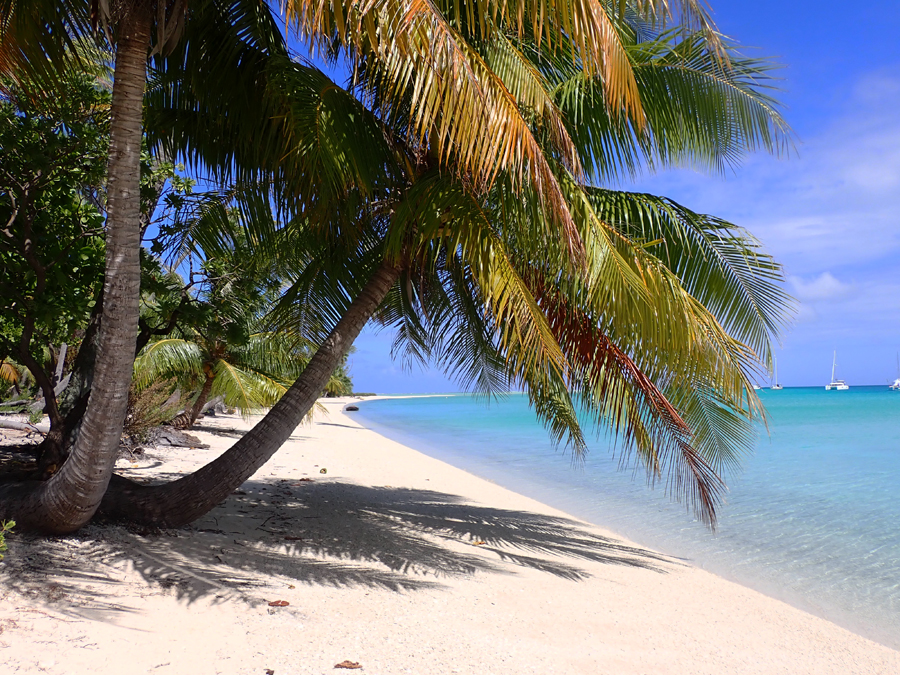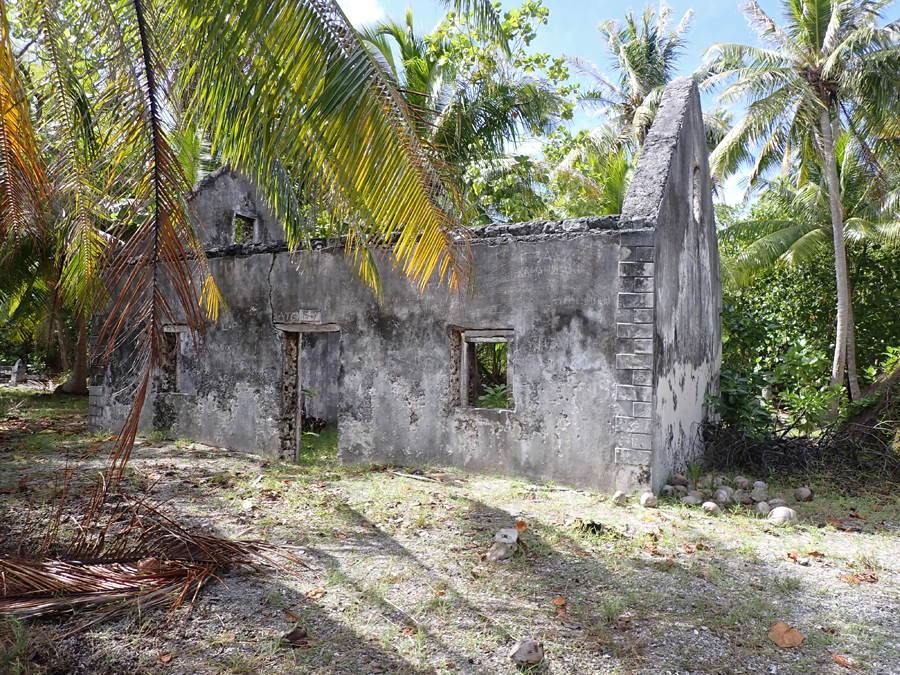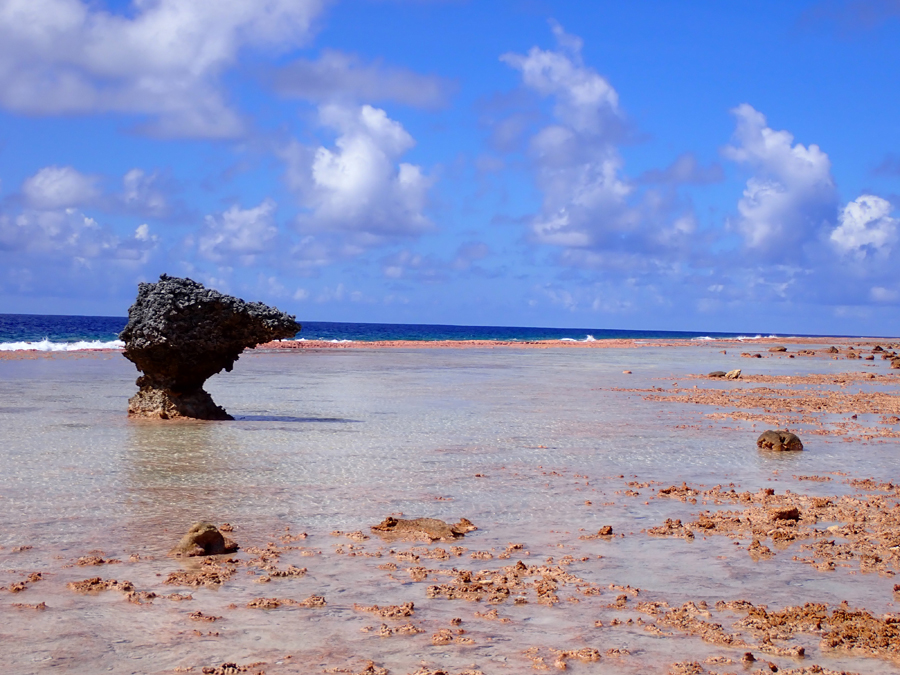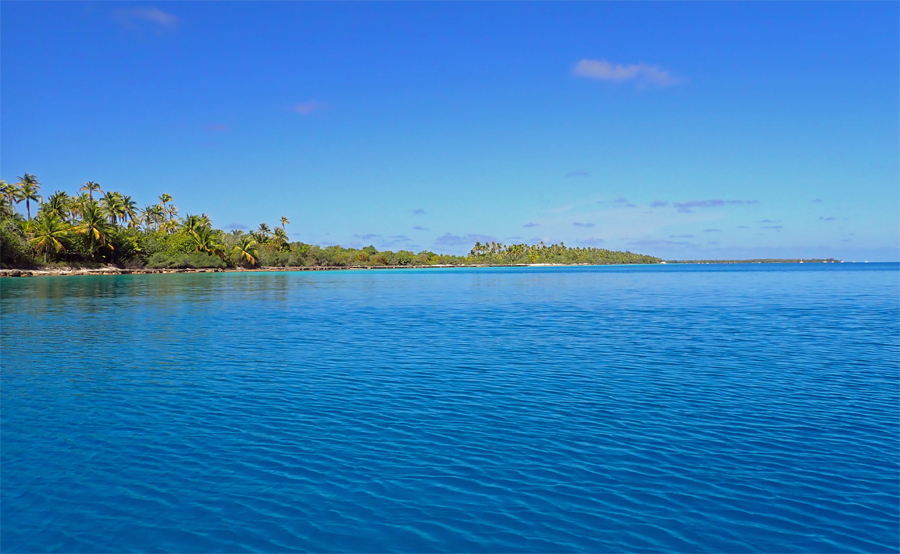
The picture travel brochures use to make people want to be here: The palm over the beach and the blue lagoon
What is there to do in Fakarava? The short answer: not much.
The internet here is either driven by a hamster in a wheel or a windmill. It seems like whenever the wind dies so does the internet. Or, perhaps the hamster collapses periodically from heat exhaustion. Or maybe, it’s a combination of both. When the trade winds become light, it feels hotter. So perhaps the hamster collapses when the winds die. I hope the readers of this post appreciate the patience of Job I’ve demonstrated to upload this post. On days like today, I silently cheer on Elon Musk and his Starlink satellite internet venture.
Music Man
It’s 5:30 am and time for revelry! There are a handful of houses at this end of the atoll and one of them loves their music. Most mornings, I am up around 5 am. The eastern horizon starts to lighten a few minutes later. Often, there is a cool breeze from the east making the morning that much more enjoyable as I sip a mug of English Breakfast Tea in the cockpit with my Times Crossword. And, then there’s music. Loud music. French Polynesians love their music.
How cool is it that a person can live in a place where there is nobody to tell them to turn the music down? It’s usually some sort of French Caribbean Reggae genre. Whatever it is, it’s happy and upbeat. Fact is, some music is just better loud. What a great way to start a day. I am treated to one or two CDs and then it’s quiet again.
At this end of the atoll, there are no utilities for the residents. Water is collected from the runoff of the roof and stored in a cistern. Electricity is solar. Gas is butane purchased in large canisters in the town at the northern end of the atoll and transported home by boat. Homes are very basic and the trees surrounding the house are often decorated with floats or buoys that have washed ashore giving the feeling of Christmas.
Like all of us using solar power, the first thing checked upon rising from a nice peaceful sleep is the battery monitor to ascertain the level of usage overnight. I like to think the music man awakes in the morning and sees he has some battery life left to use before the sun rises causing the panels to kick in and recharge the batteries. Not being one to waste energy, he blasts music across the atoll to announce he is still alive out here.

Near the music man’s house is this old abandoned building with a date over the door: 1879. Perhaps one of the earliest residents or an old church

Next to the building are two very ornate graves. I imagine the small one has a sad story behind it. Markings are long gone as the stone has aged
There is a sect of the cruising community who enjoy anchoring as close to the shore as possible. When entering the anchorage area a few boats seem to jockey for places in the shallow waters almost within wading distance of shore. Perhaps they don’t like to use their dinghies. Do these boats have a shortage of anchor chain? Or perhaps, these boaters really appreciate the music man’s genre selection and want to hear it loudly in the mornings.
We tend to push away from the shore a little bit for a couple of reasons. The main reason is the insects. Flies and mosquitoes are more prevalent closer to the shore. Often times the local people burn trash. The smoke and smell can be very annoying as it blows into the boat via the open hatches. The breeze is better away from shore. It is hot here and every additional iota of breeze wafting through the boat is appreciated. And lastly, there are rats on these islands. Rats swim. This might be just us but, we think it is disrespectful to anchor so close to someone’s house. It’s nice enough for the locals to allow us in their bay. They don’t need to see our laundry or hear our generator. No matter how beautiful we might think our boat is, it still may be an eyesore to them out of their window.
Meeting New Neighbors
When we arrived here, our plan was to just hang out for a few weeks. Keeping in mind we’ve been in downtown Pape’ete for the past couple of years. Being away from traffic noises was a big lure to atoll life. We’re in no hurry to do much at all. We just wanted a good spot to relax, swim and bask in the sunshine once in a while. Setting the anchor here can be a little tricky. There are lots of coral heads to take into account that the anchor chain can wrap around as the boat swings with the shifting wind.
Prior to leaving Pape’ete, the land of fast internet, we used Google Earth to identify some areas of the atoll where we could see minimal coral heads and lighter colored water. The lighter color indicates a sandy bottom. We marked these spots on our electronic navigation charts. There is also the option of using OpenCPN. OpenCPN is free navigational software developed and shared amongst cruisers. It has the capability of loading a high-resolution Google Earth image and plotting the boat’s position as it moves. This is another way to move across atolls with uncharted depths. We can see the coral heads, or bommies as some cruisers refer to them, as the boat moves inside the atoll.
We are using a method, new to us, referred to as floating the chain. I am not going to go into tremendous detail about this. If you wish to understand more, a friend has a great write-up on their blog about the process and how it protects the coral and anchor chain. The first spot we dropped the anchor didn’t work out too well. It must have hit shallow sand over a rock bottom and didn’t hold the first time. No big deal. We move and try again. At the next spot, about 100 meters away, the anchor held tight quickly. We started to let out some extra chain to get us to the correct depth to rode ratio (this optimized the holding power of the anchor). But as I did so, I became uncomfortable with the position of our boat to our new neighbors. They were watching us drift toward them as more chain went out and yelled at us we were too close.
If someone yells at you from their boat and you can hear them, then guess what: you’re too close. I apologized and said we’d move. The third time is a charm. From the bow, Cindy confirms she sees a big area of sand under us and we drop the hook a third time. It sticks hard and we are reassured this is deep sand. Once again we pan out extra chain since we know winds are forecasted to be quite gusty the next few days. We don’t float our chain right away since the wind direction is steady from the southeast and the boat will not swing about very much until the wind lightens and becomes more variable.
We settle in over the next couple of days and don’t do much of anything at all. We had been so busy getting things ready to get here, this is like a mini-vacation for us. We don’t put up our shade covers right away. Nor do we launch the dinghy. The dingy remains in place lashed down over the aft cabin. This is where we store it when sailing offshore. We just chill.
On day three, we hear someone saying “hello”. We are both below and have just finished breakfast. I have to quickly find my shorts. I have no idea where they are since I haven’t worn them for 3 days. I am content hanging about in my boxers. Ha! I find them on top of the printer. We pop up to the cockpit to find a couple in a dinghy alongside. They introduce themselves as our neighbors, Isabella and Santiago from the boat Nudi. They tell us how they’ve worried about us the past couple of days.
Normally as soon as a boat has dropped the anchor, people either jump in the water or take the dinghy ashore to explore. Many people travel in a method Cindy and I refer to as aerobic sailing. They tend to be in a hurry to do just about everything. They pull into an anchorage. drop the anchor, run about like mad things, and leave the next day. We are the complete opposite of this. It is a state of being that has taken a long time to master.
This state of being was an admirable trait of a couple we met many years ago in the Bahamas. We were alone in a nice cove for about three days when another boat came in. We notice the port on the transom was in Rockport Texas. Cindy, being from Texas, had to honor the friendly requirement of being a fellow Texan and insisted we stop by to say hello. We met a wonderful couple called Dave and Lea-Ann from the sailboat Nomad. One of the things that first struck me about Dave was how laid-back and mellow he was. They had been sailing for quite a few years and this is how some people find themselves. At that time, still early in our cruising life, I was still wound tightly. It was hard for me to sit in one place longer than I needed to be there. I remember having a conversation with Cindy about how I needed to be that mellow. Well, now we are.
So here we are in Fakarava chilling out when Isabella and Santiago express how they are worried about us. They tell us from their boat, they haven’t seen much activity on our boat. Our dinghy was still stored and they only saw us swimming once. We sit in the shaded parts of the cockpit and it is hard to see around the canvas we still had up as rain protection on our passage. We haven’t been to shore like most other cruisers do at this point. And, we have yet to put floats on the chain. Isabella said to Santiago, “We need to check on them. Perhaps she has killed him”.
I assure them I am alive. We tell them we plan to stay put for at least 3 weeks and hang here. We’re in no hurry. Apparently, they have done just that. They gave us some great tips about some of the places they’ve found here and the general lay of the land. We tell them we plan to explore as soon as the winds lighten up.

Finally, we launch the dinghy. We sail with it tied to the roof of the aft cabin out of the way. The pile of ropes are our mooring lines from Pape’ete. We left them out for the rain to wash as we traveled to Fakarava. Now they need to be hung out to dry.
Walking across an island in less than 30 steps
One of the places Isabella and Santiago told us about was a small cove just up island from us. It is a great spot to park the dinghy and walk to the outer side of the atoll. One day when we are joyriding in the dingy just sort of aimlessly meandering along the coast we see the area they mentioned to us. Most of the atoll at this end is covered with thick vegetation and walking inland is a challenge. However, there is a nice opening here and we decide to return with better shoes.
Well, when I say we decide to return with better shoes, I should say Cindy returned with better shoes. I had my flip-flops on and after a few minutes realize this is a mistake. The atoll is volcanic and the ground is basically solid rock. It’s hard on the feet. And, it’s also sharp. A couple of times my foot slipped in my wet flip-flop and a scraped my toes on rocks. Ouch!
From where we beached the dinging on the cove inside the atoll, it was less than 30 paces to the outer side and the blue South Pacific Ocean. Okay, maybe not thirty paces but certainly not very far. The outer edge of the atoll is like nothing I’ve ever seen. I’m not sure what I expected but it wasn’t this.
In the middle of the atoll, we reach the maximum altitude here of about 2 meters. This is all that keeps the boisterous waves from coming over the top into the interior. We walk on what appears to be just one giant grey-colored lump of lava. It’s uneven and rugged. Not the best for flip-flops. There is no sand or soil. I am amazed things grow here. How can some of these plants live? They get salt water spray and have roots going into solid rock. I’m amazed by this. I mean, plants died in our garden in Atlanta and these native to Georgia plants had treated soil and an irrigation system. American garden plants wouldn’t last five minutes here.

Watch out for these little coral florets in the tidal pools. They are sharp and will cut. Getting a cut from coral is a bad thing and can lead to serious infections – ask any surfer

This piece of driftwood reminds me of an aardvark. I can’t help but wonder where the tree originally was before it landed here.

The very outer edge of the atoll – the tidal pool is about 6 cm deep. On the outer edge there is a sheer drop to about 500 meters (1640 feet) blue ocean

Check out this strange rock eroded over time by the ocean – do you think there’s an island betting pool among the locals about when it will topple?
Once past the floral line, the ground drops to just about sea-level and we find ourselves walking in tidal pools. Most are about 6 cm deep (2.5”). Fish dart about as we make our way. We need to be careful not to step on small coral flowers and have to pay attention to where we plant our feet. Surprisingly, the rock is not slippery or slimy. Other than the unevenness of the surface and watching where to step, it’s not too difficult to move about and look for shells.
We find some beautiful shells and hold them up to the light to see if anything is living inside. If so, we put them back. Cindy quips, we use catch and release for shelling. If nothing is inside, they are keepsakes and souvenirs of this little corner of the world. There is nothing worse than taking a shell back to the Puffster and then having it reek horribly the next day because whatever was living inside died. Or, finding it has moved across the countertop during the night.
Kite School
In our corner of Fakarava is a kite school. It seems as the windier it becomes the more people are on their kiteboards. They love the wind. I see all sorts of levels of skill displayed. Some are obviously a great deal more experience than others and speed along at lightning pace almost disappearing on the horizon. Others stay close to the rescue boat and entertain cruisers on anchor with spectacular wipeouts.
One guy, in particular, is extremely good. He has a masterful control of the kite and board and often gets airborne. On one occasion I was on the very stern of the Puffster cleaning our stainless steel folding boarding ladder. I heard a noise and it was him passing our boat just about 2 meters away (6 feet). On the return trip, I saw him coming and we tried to high-five each other. Me hanging off the back of the boat and him screaming along and controlling his kite with one hand. We didn’t quite manage to touch but were almost successful – inches.
The next day, I was watching him again and he was getting air time on a particularly windy day. I grabbed the camera and tried to get a couple of pictures. He saw the camera and set himself up to come toward the boat on his next tack. Within about 10 meters (30 feet) of the boat, he did whatever he does to get airborne and let out a shriek of excitement. He came so close to the boat I thought I might have to pull pieces of him out of the rigging. But, as I said, he has incredible control.
That’s all for now. Part II is coming soon with more pics and activities. This is assuming the hamster is up to the task.












